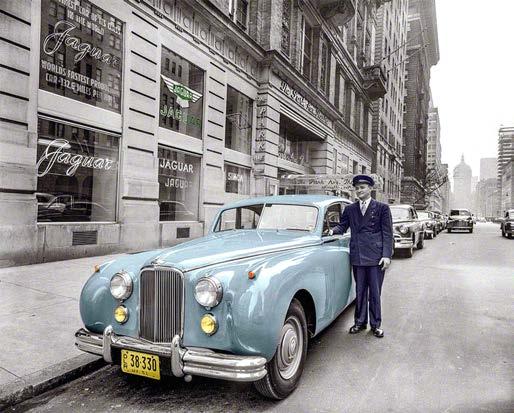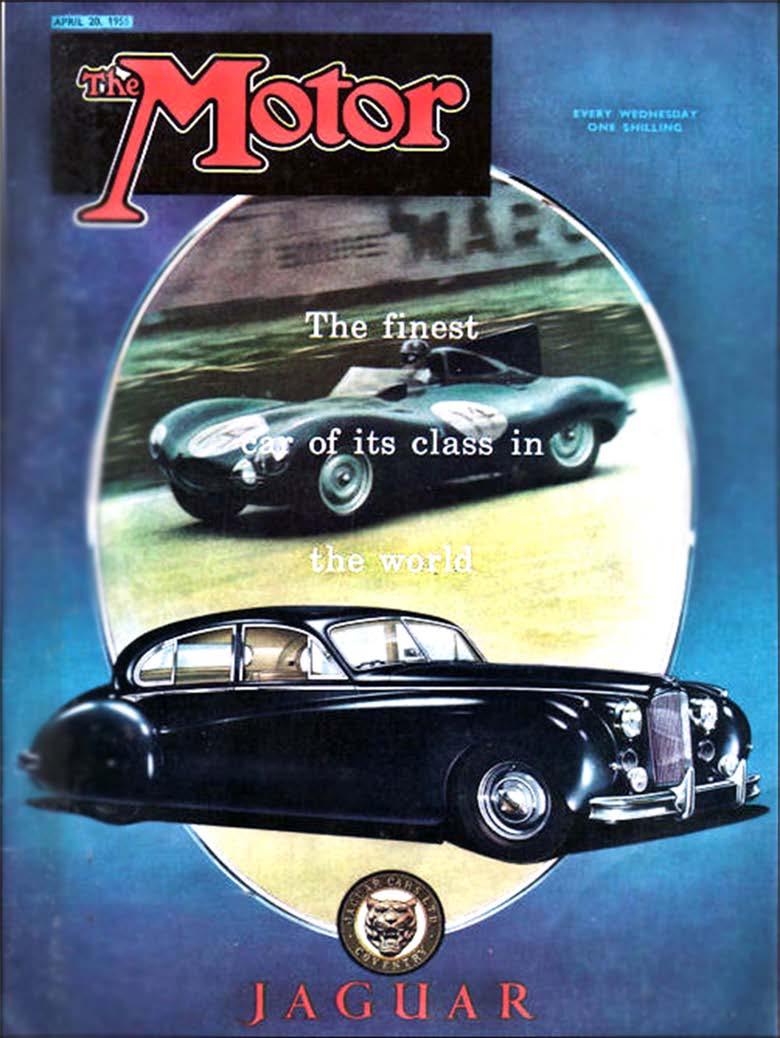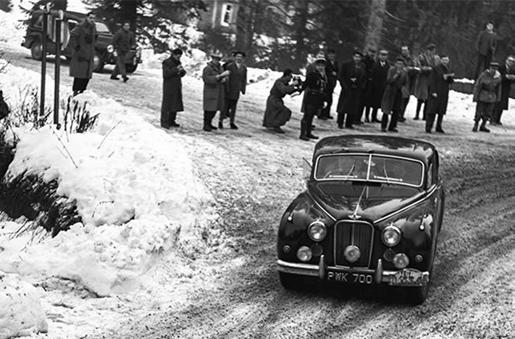
14 minute read
Feature Mark VII (1950-2020
In the 1950s, if you were an upper-crust European and wanted a large luxury sedan, but didn’t want or couldn’t hack the price of a Rolls or Bentley, you likely bought a Jaguar Mark VII. The big Jag was a good pick: rounded, voluptuous body design highlighted by a fair amount of chrome and bright metal trim, lots of wood and leather inside, a plenty powerful XK engine. It looked the part, and drove to match.
The 1950 Earls Court Motor Show saw the unveiling of the Mark VII saloon and once again Lyons ‘stole the show’. Americans took to the Mark VII and some US$30m worth of orders were taken within months of the car’s introduction. Design
The styling and size were aimed at the export market. Around 80% of production went to export which also included the Australia market. Although the new model was the successor to the Mark V, it was called the Mark VII because there was already a Bentley Mark 6 on the market. The Mark VII chassis came from the Jaguar Mark V and the wheelbase remained the same at 10 feet (3,048 mm). The new model's body looked more streamlined, with integrated headlights and mudguards, a two-piece windscreen, and longer rear overhang. As on the Mark V, the rear wheels were partially covered by removable spats.
Engine
Whereas the Mark V had a prewar pushrod engine originally developed by the Standard Motor Company, the Mark VII was powered by the newly developed 3.5 litre XK engine first seen in production form in the 1948 XK120. The 3442 cc DOHC straight-six provided 160 bhp (119.3 kW), the same as in the XK120, and the saloon's claimed top speed was over 100 mph (160 km/h). When the car was being developed, Jaguar thought it would find most of its customers overseas, mainly because UK car tax at that time penalised buyers of larger-engined cars. However, it went into production just as Britain's postwar economic austerity began to ease, and in 1951 the car's enthusiastic reception in both the British and American markets prompted Jaguar to relocate production to larger premises to the Browns Lane plant, built for wartime production.
Automatic
In 1952, the Mark VII became the first Jaguar with automatic transmission when the Borg-Warner two-speed automatic was offered as an option. (continued page 12)
1950 Earls Court Motor Show The Mk VII Jaguar was unveiled at the September 1950 car show at Earls Court, London. With its revolutionary XK motor and advanced styling, it was the star of the show. It was also far cheaper than vehicles of similar size and quality. The Mark VII was an enormous financial export success for Sir William Lyons with some US$30m worth of orders taken within months of the car’s launch in the USA.


By the time the model was upgraded to M specification in August 1954, 20,908 had been produced.
Mark VII M (1954–1956)
The Mark VII M was launched at the British International Motor Show in October 1954. Distinguishing the Mark VII M from its predecessor, circular grilles over the horns were installed below the headlights in place of the former integrated auxiliary lamps, which were moved slightly further apart and up-rated and mounted on the bumper. New headlamps were given “Le Mans” type diffuser glasses. Both bumpers now wrapped further around the sides of the car and new large tail lamps with built-in reflectors now incorporated direction indicators with flasher-type traffic indicators replaced semaphore arms. Seats were now full length and incorporated Dunlopillo. The four-speed manual gearbox remained the standard fitting but was now constant mesh and fitted with closer ratios, while the Borg Warner automatic, hitherto available only on exported Mark VII’s, now became optional for British buyers.
Suez Fuel Crisis
In 1956, with the advent of the British anticipated fuel rationing, and “bubble cars” appearing on the streets. Jaguar switched focus to their smaller saloons. The Mark I 2.4 litre had been introduced in 1955 and therefore none of its increasingly powerful but fuel-thirsty successors would match the production volumes of the original Jaguar Mark VII. Before it was superseded by the Mark VIII, over 30,000 (30,969) Mk VII’s and Mk VII M’s were produced.
1951 Mark VII advertisement for the Jaguar dealership on Park Avenue boulevard, New York City. Note the integrated auxiliary lamps located below the main headlights
1953 Upgrade Larger torsion bars were fitted to the The Big Cat’s first significant upgrade front suspension. came in 1953 when telescopic shock Although the engine continued with the absorbers replaced lever action units same capacity and 8:1 compression ratio, and the optional two-speed automatic the introduction of new high-lift cams became a three-speed auto and was soon increased the amount of power to 190 being fitted to four out of every five Mark bhp (141.7 kW), giving the car a claimed VII’s they built. top speed of 104 mph (167 km/h).
Racing and Rallying
Though a large car, the Mark VII was raced extensively and successfully. It was the touring car racer of choice back in the day, having been raced by, among others, Stirling Moss and later F1 champion Mike Hawthorne. Mark VII’s were never beaten in the Silverstone Daily Express one-hour Trophy Production Touring Car race, winning 5 years running. The Mark VII also proved to be a very
(continued page 13)
effective rally car.

European advertisement for 1954 Mark VII M. It can be distinguished from it’s predecessor by the circular grilles installed below the headlights and auxiliary lamps mounted on the bumper which now wraps further around the sides of the car. Also visible are flasher type traffic indicators that replaced semaphore arms previously located between the doors.
Success included: ◊ NASCAR Dayton Speed Trials, 1952:
Tom McCahill Mk VII - won the
Sedan class at 100.9 mph record. ◊ RAC Rally, 1952: Mk VII fastest in class (Tommy Wisdom) ◊ Monte Carlo Rally, 1952: Mk VIIs in 4th (Rene Cotton), 6th (Jean
Herurtaux), 15th (Wadham/Waring). ◊ Tulip Rally, 1952: Mk VII (PNW 7) in 2nd (Ian Appleyard & Pat Lyons) ◊ Silverstone (race), 1952: Mk VII (LWK 343) in 1st (Stirling Moss), 4th (Bertie
Bradnack) ◊ Jabbeke, Belgium (speed record), 1953: Mk VII (LWK 343) (Norman
Dewis), 121.704 mph ◊ Monte Carlo Rally, 1953: Mk VII (PNW 7) in 2nd (Ian Appleyard & Pat
Lyons), Mk V in 5th (Cecil Vard), Mk
VII in 8th (Donald Bennett) ◊ Silverstone (race), 1953: Mk VII (LWK 343) in 1st (Stirling Moss) ◊ Round Britain Rally, 1954: Mk VII in 1st (E. R. Parsons) ◊ Silverstone (race), 1954: Mk VIIs in 1st (Ian Appleyard), 2nd (Tony Rolt), 3rd (Stirling Moss), 5th (Ronnie Adams)
SUM 7: MK VII M Jaguar during the 1955 Monte Carlo Rally, driven by Ian Appleyard & Pat Lyons before blowing a Welch plug. They managed to fix it and finished to help claim the Team Trophy. Note the twin demisters fitted to both front screens with rubber suckers. Ian Appleyard previously won in this same car at Silverstone in 1954.
◊ Silverstone (race), 1955: Mk VIIs in In August 1956, at Road America, 1st (LWK 343) (Mike Hawthorne), in Elkhart Lake, Wisconsin, Paul 2nd (PWK 700) (Jimmy Stewart), 3rd Goldsmith's Mark VII won the 100-mile (PWK 701) (Des Titterington) NASCAR Grand National race for cars ◊ Monte Carlo Rally, 1956: Mk VII in up to 3500 cc. 1st (PWK 700) (Ronnie Adams) In 1954 Jaguar built a lightweight ◊ Silverstone (race), 1956: Mk VIIs in Mark VII M which, although intended 1st (OVC 69) (Ivor Bueb), 4th (Paul for racing, never participated in
Frere) contemporary events. Road-registered KRW 621, it had magnesium body panels, D-type engine, Dunlop disc brakes and modified suspension. (See
page 44). Collectability
The last Mark VII to leave the production line was a LHD ‘M’ series car built in July 1957.

LWK 343: Mk VII Jaguar prepared for the 1952 Monte Carlo rally and fitted with a makeshift radiator blind to maintain engine temperature in the freezing conditions. This Jaguar also won at Silverstone in the same year in the hands of Stirling Moss, and was used the following year to gain a speed record (121.704mph) at Jabbeke, in Belgium, in the hands of Jaguar test driver Norman Dewis. Moss again won in this car at Silverstone in 1953, and in 1955 Mike Hawthorne led home a trio of Mk VII Jaguars to win at Silverstone in this very car.

The Mk VII shape with upgrades and detail changes lasted 10 years and was an important modern limousine to offer alongside the compact Jaguars. Of the 47,000 Mark VII/VIII/IX Jaguars made, a surprising number have survived, especially in Australia. More than a few have served as wedding hire cars. Fully-restored Mark VII’s in excellent order have increased in value since the late 1990s but are still unlikely to cost much more than $35,000. That contrasts with the money being paid in rust-ravaged Britain where similar vehicles command $60-$70,000. .
Her Majesty Queen Elizabeth, the Queen Mother took delivery of a Mark VIIM in 1955 and kept it for her private motoring until 1973. The car started off as a standard auto MkVII in black with red upholstery. However, whilst it was being built at Browns Lane, she visited Hoopers the Coach-builders in London, to see a body they were building for her on a DK400 Daimler Chassis. Whilst there she also saw a Bentley finished in a special metallic version of the Royal colour Claret and trimmed in a very attractive grey interior. She then announced that she would like her Jaguar done the same. Jaguar then had to do another car, finished in primer, with no upholstery, for Hoopers to paint and trim. According to Lofty England, Hoopers work cost more than the cost of the actual car, but added that the interior used in the later MkVIII’s was very much like the Queen Mother’s MkVII. At that time, Princess Margaret was not married, and was living with her mother at Clarence House, and she too drove the MkVII after it had been delivered. At one stage the Queen Mother advised that she found the steering a bit heavy so Jaguar fitted power steering in her car
The Queen Mother, seen here being chauffeur driven in her MkVII to attend a concert in 1957.

and at the same time fitted a MkVIII onepiece windscreen and radiator grille. As time went on, the car was updated with other features from the Mark VIII/IX models including improved lighting and all-round disc brakes. It is understood that the Queen Mother loved the car as she kept it for 17 years until 1972 when she bought a one-of Jaguar XJ Vanden Plas V12. (Vanden Plas specifications were only built on Daimlers). The Queen Mother kept the 1973 XJ12 right up until her death in 2002. Her MkVII came back to Jaguar in 1973 and is now part of the Jaguar Daimler Heritage Trust. . Editor - Information for this story was gathered from a February 1986 edition of Australian Jaguar Magazine and the Jaguar/Daimler Heritage Trust.
The Queen Mother took delivery of this Mark VII in 1955 and kept it for her private motoring for 17 years. The Jaguar was finished in a special metallic version of the Royal colour Claret. After noting that she found the steering a bit heavy, power steering was fitted, and overtime her MkVII was progressively updated with other features from the Mark VIII/IX models. The car is now on display at the Jaguar Heritage Trust .


Jaguars performance in the most famous of all rallies, the “Monte” were consistently outstanding during the nineteen-fifties.
Monte Carlo Rally
The Monte Carlo Rally is the oldest rally car race in the world, and still continues today. In 2020, being run in January, the pre- COVID-19 Rally went ahead as normal for the 88th time with 30 cars travelling a total distance of 1,500 km (935 miles).

However, in the 1950s the rally involved over 300 competitors travelling more than 2,000 miles over rough terrain and snow-covered alps. Winning the Monte Carlo Rally in the 1950’s was a big deal. The cars started at various points around Europe and following ‘concentration’ routes of around 2,000 miles to bring them to Chambery in Southern France. An average speed of 50 kmh had to be maintained throughout with competitors dealing with delays caused by anything from snowstorms to fog. The cars had to maintain the same average speeds over loose surface roads across the alps before reaching Monaco. There the leading 100 cars took part in a handicap time trial around the grand prix course and further
PWK 700 on its way to win the 1956 Monte Carlo Rally. Most of the Jaguar Works team drivers consisted of talented Irish amateurs. Winning the Monte Carlo Rally was no easy feat and out of the 351 cars that started, only 233 finished the gruelling 1956 rally.
navigation and breaking tests down the Col de Turini and other mountain passes to decide the final results.
Early 1950’s
In 1951 Irishman Cecil Vard finished third in his Mk V Jaguar and in 1952 French-crewed Mk VII’s finished 4th (Rene Cotton) and 6th (Jean Heurtaux).
Only 18 cars finished the 1952 race.
Then in 1953, Ian Appleyard with his wife Patricia “Pat” Lyons, in their Mk VII (PNW 7) finished second, a single point behind the eventual winner. Cecil Vard finished 5th in his now obsolete Mk V with Jaguars (MkVII’s) finishing in 8th, 11th and 15th to claim the Charles Faroux Cup Team Award for Jaguar. Adams and Vard finished 6th and 8th respectively in 1954 driving their own privately entered Mark VII’s.
The second works Jaguar driven by Irishmen Cecil Vard, Arthur Jolley and Jimmy Millard in the ex Stirling Moss LWK 343, the same Mk VII that he used to success in British Touring Car racing. Unfortunately their 1956 chance of a win ended when they were hit by another car.

In 1955, Jaguar again won the Team Award but failed to secure an outright win, and it was beginning to look as though Jaguar cars were destined to be the bridesmaids of Monte Carlo. Following the horrific Mercedes Benz crash at Le Mans in 1955 and with the death of John Lyons at the same time, Jaguar decided to wind down its involvement in motorsport.
Monte Carlo 1956
However, Jaguar did proceed with a two car works team in 1956 with PWK 700 (Adams) and LWK 343 (Vard). The cars started at Glasgow and battled icy roads down to the first checkpoint. The ice eventually cleared giving an easier run through England and France. Disaster struck the Vard car (LWK 343) when it was hit by another vehicle, and the delays to repair the Mk VII cost them hundreds of penalty points.
The winning dark green MkVII driven by experienced Irishmen Frank Bigger (left), Ronnie Adams and Derek Johnston (right). Seen here with five Team-trophies. The team also won £1,200 in prize money. The rally was cancelled in 1957 due to the Suez fuel crisis.
PWK 700 had better luck, reaching Monte Carlo without any penalty and only dropping a second to the fastest Porsche on the half mile braking test. On the very last day the Jaguar went into the lead. The final test was on a demanding 250mile course through the mountains and over the rain swept Col de Turini with strict minimum and maximum speeds to be observed. When the results were announced that night they were confirmed as winners with a 3-point lead over the second placed Mercedes. The following day, Prince Rainier presented the works team with no less than five trophies and £1,200 in prize money. The drivers then started a week of press and radio interviews and television appearances after the team and car were flown back to England. Even with the great publicity, Jaguar refused to change their mind about ending full works involvement in rallying. Privateers in their Mk 7’s entered the 1957 race but due to the Suez crisis and petrol rationing, fuel coupons were not issued for rallying and the January race was cancelled. With the launch of the 3.4 Mk 1 a month later in February 1957, large Jaguars were of no further interest to rally drivers, and although the rallying Mk VII’s gave way to the smaller saloons,

they left their mark in the motoring history books with the only Jaguar to win the Monte Carlo Rally. .











